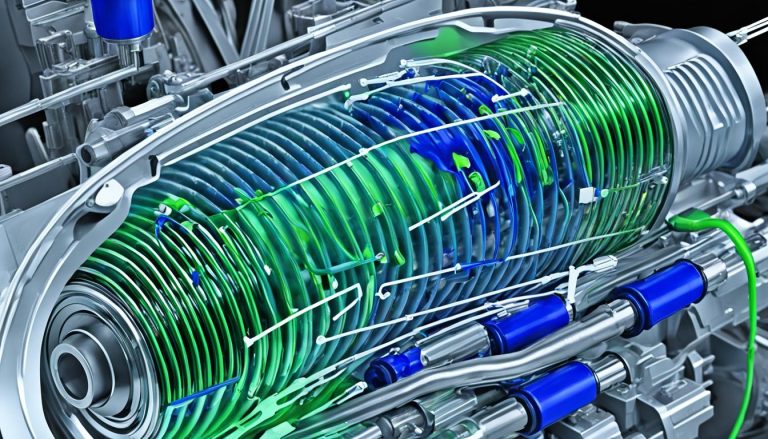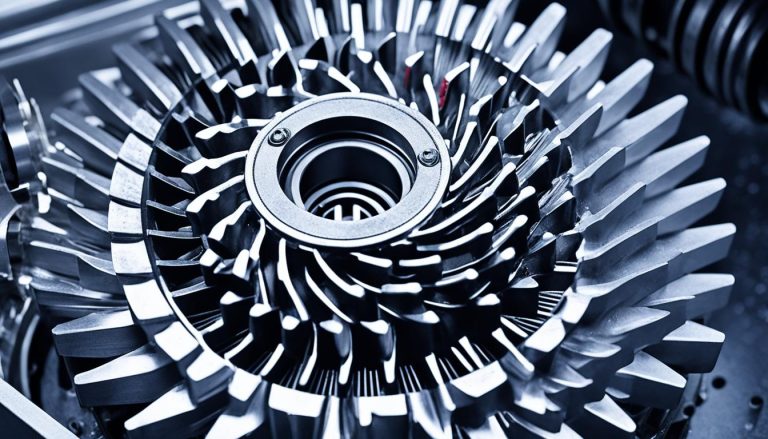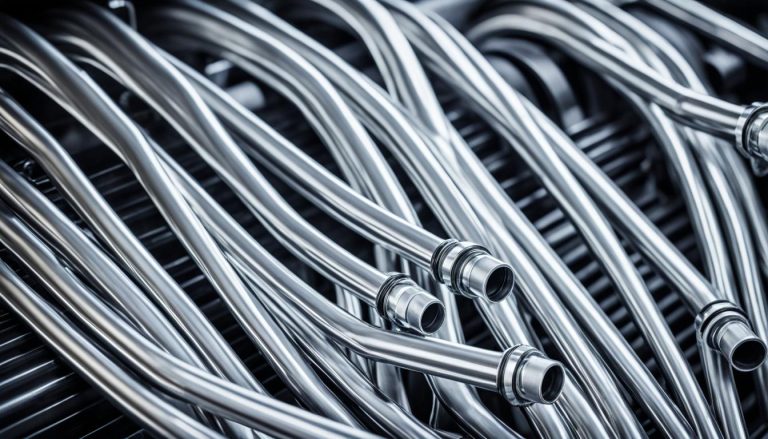Best Transmission Filter Replacement Guide
Maintaining your vehicle’s smooth operation hinges on the health of its transmission system, and central to this is the often-overlooked transmission filter. A vital component, the transmission filter acts as a vigilant guardian, ensuring that your automatic transmission fluid (ATF) is free of harmful debris and contaminants. With regular use, your vehicle’s transmission filter accumulates an assortment of particles, which necessitates timely transmission filter replacement to avoid any potential hiccups in your driving experience.
Whether you’re a hands-on car enthusiast or prefer the assurance of professional services, understanding the process of changing the transmission filter is beneficial. For automatic transmissions specifically, it becomes pertinent to either replace the automatic transmission filter or perform a thorough change transmission filter service roughly every 30,000 miles or 30 months. Doing so not only contributes to the longevity of your vehicle’s transmission but also assures that your rides remain as smooth as they were when you first turned the key in the ignition.
Embarking on a DIY transmission filter replacement can be both a cost-efficient and rewarding endeavor. All it takes is basic tools, the appropriate automatic transmission filter kit, and a sprinkle of patience to begin the journey of ensuring your vehicle’s performance is optimized. Heed the advice provided in this guide to prevent common pitfalls and ensure that your transmission’s health is never taken for granted.
Key Takeaways
- Regular maintenance of the transmission filter protects and prolongs the life of your vehicle’s transmission.
- Replacing the transmission filter is recommended every 30,000 miles or 30 months for automatic transmission vehicles.
- Signs like transmission slips, rough shifts, and unusual noises can indicate the need for a transmission filter change sooner rather than later.
- Performing a transmission filter replacement yourself can save money and offers a sense of accomplishment.
- Proper selection and installation of the transmission filter ensure the ATF remains clean, safeguarding against future transmission issues.
The Importance of Regular Transmission Filter Changes
Meticulous upkeep of the transmission fluid filter is a non-negotiable aspect of automobile maintenance that sustains the performance and longevity of your vehicle. Fundamental to this process is understanding when to change transmission filter and recognizing the impending symptoms of a filter needing attention. A well-maintained filter ensures the ATF (Automatic Transmission Fluid) continues to fulfill its dual roles effectively.
Key Functions of Vehicle Fluids: Lubrication and Cleaning
The transmission fluid is the lifeblood of the transmission system, playing a critical role in minimizing friction and preventing the wear of moving parts. Simultaneously, it acts as a detergent, picking up and carrying away the microscopic invaders that threaten to undermine the transmission’s integrity. Over time, these contaminants are captured by the transmission fluid filter, safeguarding the system from potential damage.
Recommended Service Intervals for Automatic Transmissions
Industry standards suggest a routine service interval for automatic transmission filters roughly every 30,000 miles, or every 30 months—whichever milestone is reached sooner. Sticking to this service interval is a proactive step towards ensuring the ongoing health and efficiency of your vehicle’s transmission system.
Identifying the Need for a Filter Change: Warning Signs
While adherence to service schedules is advised, certain clogged transmission filter symptoms warrant immediate attention. Should you encounter hesitation during gear shifts, grinding noises, or detect dark and burnt-smelling ATF, it might indicate a reduced filter efficacy before the proposed service interval. Addressing these issues promptly can mitigate the risk of more severe transmission problems down the line.
To maintain the optimal performance of your vehicle, notice how it behaves, listen to it, and be attentive to the signals it sends. Your transmission’s functionality and reaction time are key indicators of its health—a healthy transmission translates to a reliable car.
Understanding Transmission Filter Mechanics
Transmission filters are critical components designed to maintain cleanliness and integrity within an automotive transmission system. Their main task is to sieve out harmful contaminants and debris that could potentially lead to transmission issues, ensuring vehicle longevity and performance. Particularly with solutions like the Allison transmission filter, vehicle owners can expect superior filtration capabilities designed for robust operation. This section delves into how these filters work and the distinctions between various types
How Transmission Filters Capture Debris
Essentially acting as a safeguard, transmission filters trap metal shavings, dirt, and other particles within the transmission fluid. Over time, a filter can become clogged, leading to dirty transmission filter symptoms such as difficulty in shifting gears or unusual sounds from the transmission. It’s crucial to acknowledge these symptoms promptly to avoid compromising the transmission’s functionality.
The Difference Between External and Inline Transmission Filters
An inline transmission filter is integrated directly within the transmission fluid line. This arrangement allows the filter to clean the fluid as it passes through the line repeatedly. On the other hand, an external transmission filter is installed outside the main transmission case and is typically used as a supplementary filter to further purify the transmission fluid before it enters the system.
- Inline Filters: They provide consistent filtration and are designed to fit within the existing transmission architecture without additional modifications.
- External Filters: Offering an added level of filtration, external filters require some modification to install but can extend the life of the primary internal filter.
Both filter types play pivotal roles in keeping transmissions clean, but the external option is particularly beneficial for those looking to enhance their vehicle’s filtration system. However, adding an aftermarket external transmission filter can alter the fluid dynamics within the transmission, potentially leading to issues if not matched correctly to the system’s requirements.
In conclusion, understanding how transmission filters work, recognizing the warning signs of a dirty filter, and choosing the correct filter type are all vital aspects of maintaining a vehicle’s transmission system. Whether you opt for an inline or external solution, such as an Allison transmission filter, always consider the manufacturer’s specifications and the potential implications of aftermarket modifications.
Step-by-Step Guide to Changing Your Transmission Filter
Doing a transmission filter replacement by yourself can be a rewarding process, especially if you’re experiencing bad transmission filter symptoms like slipping gears or delays in acceleration. With the right guidance and adherence to safety standards, you could change the transmission filter and restore your vehicle’s performance to its optimum level. Adequate preparation is the key first step to successfully change your automatic transmission filter.
Preparing the Necessary Tools and Parts
Begin by gathering all the tools and new parts you will need. This includes purchasing the correct type of transmission oil filter specific to your vehicle, a new O-ring that seals the filter in place, and a pan gasket to prevent leaks once the pan is reattached. Ensure you have the recommended transmission fluid on hand, as you will need to refill the system after the filter has been replaced.
Safety Precautions and Protective Gear
Before starting, it’s essential to prioritize your safety by wearing protective gear. Durable gloves will protect your hands from sharp edges and any corrosive fluids, while safety goggles will shield your eyes from unexpected splashes. Don a pair of robust shoes to safeguard your feet, and if you’re working under the car, a helmet can provide much-needed head protection.
Draining Old Transmission Fluid
The first actual step in the filter change process is draining the old transmission fluid, a crucial task that requires a steady hand and careful approach. Locate the drain plug for the transmission pan—if your vehicle does not have one, the pan needs to be carefully removed to access the old filter.
Removing the Transmission Pan and Old Filter
With the fluid drained, you can proceed to remove the transmission pan. Be prepared for residual fluid. Once the pan is off, you can remove the old filter. Pay attention to how it is fitted to install the new one correctly.
Cleaning the Pan and Installing the New Filter
With the old filter out, take the opportunity to clean the pan thoroughly, wiping away any remaining fluid and removing metal particles from the magnets inside of it. Install the new transmission filter, ensuring that the O-ring is well-lubricated to prevent any leaks. Secure everything back together, taking care to tighten bolts to the proper torque specified for your vehicle.
Once everything is reassembled, refill your vehicle’s transmission with the appropriate type and amount of fluid. A successful change will improve your automatic vehicle’s performance and prolong the life of your transmission.
Maintaining Your Transmission: Fluid and Filter Tips
Transmission health is pivotal to the longevity and performance of your vehicle. Regular checks and maintenance can save you from costly repairs down the line. But what does that entail? Let’s delve into the two critical aspects of transmission upkeep: the quality of transmission fluid and the state of the filter.
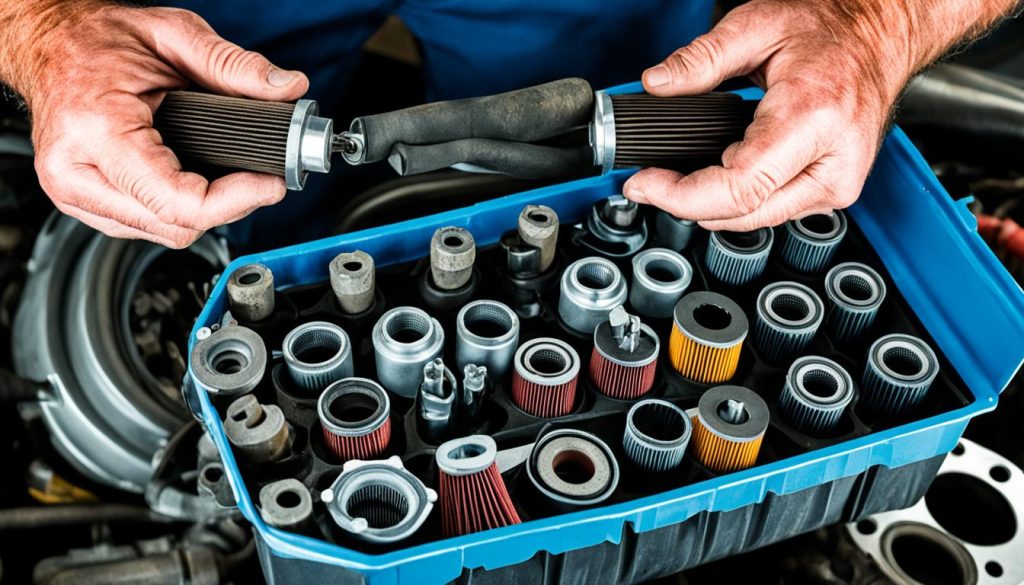
Assessing Fluid Quality: When to Schedule a Change
The condition of transmission fluid is an excellent indicator of when it’s time for a transmission filter replacement. If you notice that the fluid has taken on a dark color or exudes a burnt odor, it’s an immediate sign that your transmission is calling out for attention. Don’t delay this service as it’s vital for the health of your vehicle’s transmission.
Choosing the Right ATF and Filter for your Vehicle
To safeguard the intricate workings of your transmission system, selecting the appropriate transmission fluid filter and transmission oil filter cannot be overstressed. As each make and model requires specific types of fluids and filters, consulting your manufacturer’s guidelines is essential. For those vehicles equipped with an Allison transmission filter, premium filters are non-negotiable to ensure optimal functioning.
When performing a fluid change, it’s a smart move to have an extra quart or two of fluid on hand. Spillages happen, and being prepared will prevent any unnecessary trips back to the auto parts store. Especially for individuals who are not as mechanically inclined, seeking advice through car forums or relying on professional guides can assist in making an informed choice on the correct ATF and filter for your car model.
Keep in mind that while many transmissions have serviceable filters, it’s not a universal feature. It’s always recommended to check the specifics for your vehicle or seek out professional advice if you’re uncertain about performing a transmission filter replacement.
Note: Always dispose of old transmission fluid safely and in compliance with your local regulations to help protect the environment.
Decoding Transmission Filter Issues
Vehicle owners might not always recognize when their transmission filter isn’t performing as it should. Yet, understanding and diagnosing issues related to a clogged, bad, or dirty transmission filter is imperative for the health of your vehicle. Early detection of potential problems can sidestep costly repairs down the line, ensuring your transmission remains in optimal working condition.
Recognizing Clogged Transmission Filter Symptoms
Being alert to the signs of a clogged transmission filter is crucial in automotive care. Symptoms can be quite apparent if you know what to look and listen for. When the filter is blocked, it is unable to perform its primary task – keeping contaminants out of the transmission fluid. This can manifest in various ways, from rough shifting and slippage, to unusual noises emanating from the transmission.
Consequences of a Bad or Dirty Transmission Filter
If warning signs of dirty transmission filter symptoms or bad transmission filter symptoms are ignored, drivers may face severe and costly repercussions. The flow of transmission fluid can become restricted, diminishing its ability to lubricate effectively and keep the transmission system cool. This can lead to increased friction, wear, overheating, and ultimately, the potential failure of the transmission.
Maintaining the transmission through vigilant monitoring of the filter and fluid quality is therefore imperative to the lifecycle of your vehicle. Let’s delve into a detailed comparison of the symptoms and consequences associated with problematic transmission filters:
| Symptom | Possible Causes | Immediate Consequences | Long-Term Consequences |
|---|---|---|---|
| Rough Shifting | Clogged or dirty filter | Jerky or harsh gear transitions | Wear on clutch plates and gears |
| Slippage | Insufficient fluid pressure | Inability to stay in gear | Potential transmission rebuild or replacement |
| Delayed Engagement | Restricted fluid flow | Higher RPMs without acceleration | Additional stress on transmission components |
| Noise in Neutral | Contaminants in fluid | Sounds like knocking or whining | Further damage from circulating debris |
Taking prompt action upon noticing these symptoms can save not just the transmission but also your peace of mind as a vehicle owner. Keeping up with routine maintenance schedules and performing fluid and filter changes as needed ensures your car remains reliable and ready for the road ahead.
Troubleshooting and FAQ: Transmission Filter Concerns
Many drivers find themselves puzzled over the maintenance of their vehicle’s transmission system. Questions frequently arise about whether it’s possible or practical to change the transmission fluid without also replacing the filter, and where to even find the transmission filter on their vehicle.
Can I Change My Transmission Fluid Without Changing the Filter?
Technically, it is possible to change transmission fluid without changing the filter, yet expert mechanics do not advise it. When you refresh the transmission fluid but leave a potentially clogged or old filter in place, you miss the opportunity to remove all the trapped contaminants. Those contaminants could then mix with the new fluid, effectively diminishing its quality and possibly leading to future transmission issues.
Where Is the Transmission Filter Located?
The transmission filter is a critical part of a vehicle’s transmission system and knowing where the transmission filter is located can be vital for DIY maintenance. Typically, the filter is mounted on the bottom of the transmission, requiring the removal of the transmission pan to access it. However, the layout may vary by make and model, which means consulting your vehicle’s owner manual or a certified service technician could provide the precise guidance needed for your particular vehicle.
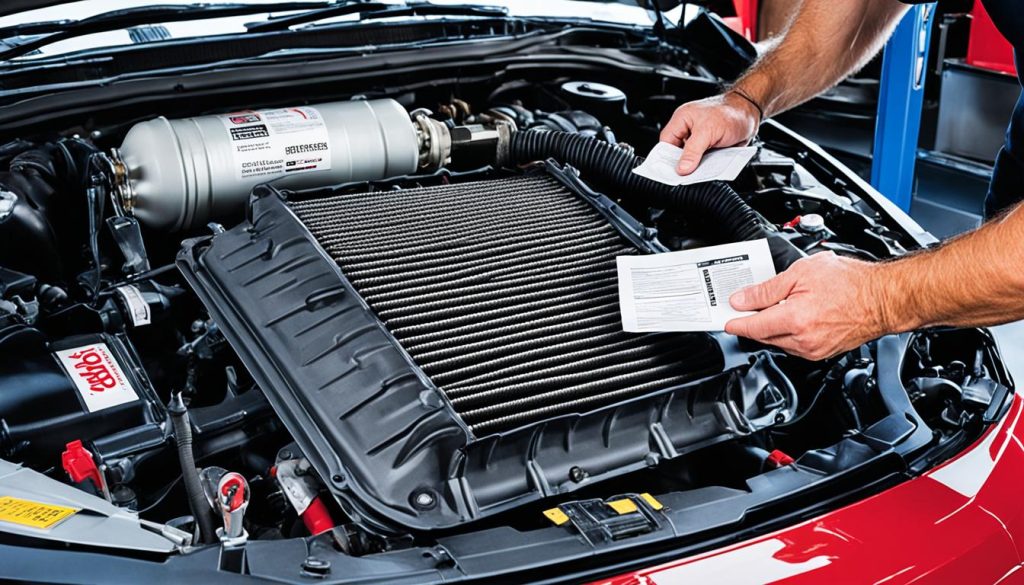
| Transmission Maintenance Task | Recommended? | Benefits | Considerations |
|---|---|---|---|
| Change Transmission Fluid | Yes | Maintains fluid integrity and lubrication | Old fluid must be properly disposed of |
| Change Transmission Filter | Yes | Ensures clean fluid and protects transmission components | Potentially messy, may require specific tools |
| Change Fluid Without Filter | No | N/A | Leaves old contaminants in place, could harm transmission over time |
Understanding the intricacies of transmission maintenance is essential for ensuring the longevity and reliability of your vehicle. While shortcuts might seem tempting, they almost invariably lead to more complex and costly repairs down the line. Therefore, taking the time to change the transmission filter when you’re updating your transmission fluid is a smart and economical choice for conscientious vehicle owners.
Advanced Transmission Filter Solutions
Vehicular maintenance enthusiasts and professionals alike continually search for ways to enhance the performance and longevity of transmission systems. To meet this demand, advancements in transmission filter technology offer innovative solutions for more rigorous filtration. These solutions not only aim to improve overall vehicle health but also challenge traditional methods of transmission system care.
Options for Enhanced Filtration: Inline and External Filters
Increasingly popular among intensive transmission maintenance plans are the inline transmission filter and the external transmission filter. These advanced filters offer a more fine-tuned approach to filtration, potentially capturing smaller particles that conventional filters may overlook. By integrating an inline filter directly into the transmission line, it works continuously with the fluid flow, enhancing the cleanliness of the transmission fluid. On the other hand, an external transmission filter provides an additional layer of protection, although it may require modifications for proper integration into the system.
Aftermarket Modifications: Pros and Cons
The decision to upgrade with aftermarket parts such as additional filters or coolers requires careful consideration. For those willing to invest in a transmission filter replacement, the benefits can be substantial, presenting the possibility of extending the life of the transmission through improved filtration. However, it’s important to acknowledge the balance between these enhancements and the design of the vehicle. Custom modifications can, at times, disrupt the harmonious functioning of a car’s transmission by altering fluid flow rates or overriding built-in temperature controls, emphasizing the importance of comprehensive understanding and expert installation when considering such upgrades.
Awareness of the pros and cons associated with aftermarket transmission filter enhancements is key for vehicle owners striving to push their maintenance beyond factory standards. Refined filtration can lead to smoother transmission operation and longevity, but only when implemented with precision and a deep respect for the vehicle’s original engineering principles.
DIY vs Professional Transmission Filter Replacement
When the time comes to replace your vehicle’s transmission filter, you are faced with a choice: undertake the task yourself or seek out a professional filter replacement service. Both options have distinct advantages and considerations, which we will explore to help you make an informed decision tailored to your needs and capabilities.

What to Expect When You DIY
Engaging in a DIY transmission service can be a cost-effective and rewarding venture for those who possess mechanical aptitude and the necessary tools. It allows vehicle owners to take a hands-on approach, gaining a greater understanding of their vehicle’s inner workings. While it does require a significant investment of time and effort, successfully completing a transmission filter replacement amplifies your sense of ownership and achievement. Here’s what to expect:
- An initial investment in the correct tools and replacement parts, such as the automatic transmission filter.
- Sufficient research, including vehicle-specific guides and tutorials.
- Attention to detail, particularly when it comes to properly draining transmission fluid and disposing of it according to local regulations.
- Ensuring compatibility and correct installation of the new filter to avoid potential transmission issues.
Benefits of a Professional Filter Replacement Service
Choosing a professional filter replacement service offers distinct advantages, particularly for those with limited mechanical experience or for tasks that exceed one’s comfort level. Professionals bring expertise and specialized tools to the table, often guaranteeing the quality of their work. Moreover, a service center can perform diagnostic checks to uncover any additional issues that may not be apparent during a standard filter replacement. Here’s why you might opt for professional service:
- Access to expert technicians who are experienced in handling a wide range of transmission issues.
- Possibility of a service warranty, providing peace of mind and protection for the work and parts used.
- Higher likelihood of accurate, efficient service, potentially identifying other maintenance needs during the inspection process.
- Convenience of avoiding the hassle and mess associated with a DIY transmission service, allowing you to spend your time on other pursuits.
Whether you opt for a DIY transmission service or a professional service, the key is to ensure the task is performed correctly to maintain the seamless operation of your vehicle’s transmission system.
Cost Analysis: Saving Money with DIY Transmission Service
Initiating a do-it-yourself approach for transmission service can be a shrewd financial move, offering significant savings on labor costs associated with professional services. By mastering the art of transmission filter replacement, you not only save on immediate expenditure but also contribute to the long-term health and efficiency of your vehicle.
Estimating Tool and Part Expenses
Embarking on a DIY transmission service starts with a thorough cost assessment. Sourcing the right tools and high-quality parts, such as a durable transmission filter, is an essential investment that guarantees the effectiveness of your efforts. The following table presents a breakdown of potential costs encountered during DIY transmission filter replacement:
| Item | Cost | Notes |
|---|---|---|
| Transmission Filter Kit | $15 – $50 | Includes filter, O-ring, pan gasket. |
| High-Quality Transmission Fluid | $30 – $100 | Varies by vehicle make and model. |
| Basic Tools | $20 – $100 | Includes wrenches, funnel, drain pan. |
| PPE (Personal Protective Equipment) | $10 – $30 | Gloves, goggles, etc. |
| Grand Total | $75 – $280 | Approximate total investment for a single DIY service. |
Long-Term Financial Benefits of Regular Maintenance
Investing in regular maintenance benefits your wallet in ways that surpass saving on the transmission filter replacement cost alone. Proper care, which includes timely filter changes and fluid inspections, can avert costly repairs down the road. It maintains transmission integrity, ensures smoother vehicle operation, and can positively impact fuel efficiency. In essence, the benefits of routine maintenance manifest as a form of preventive savings, safeguarding against the significant financial strain of major vehicle repairs.
The Role of the Transmission Filter In Vehicle Longevity
Optimal functionality and longevity of a vehicle’s transmission system are deeply intertwined with the health of the transmission filter. Akin to how a robust filter for the body’s circulatory system would shield it from harm, a quality transmission filter acts as a guardian for your vehicle. It targets harmful particles and contaminants that can tarnish the transmission’s internal environment. Understanding the significance of this role emphasizes why regular checks and maintenance of the transmission filter are cornerstones of vehicle care.
How Good Filtration Practices Extend Vehicle Life
Adhering to good filtration practices is more than a maintenance task; it’s an investment in your vehicle’s future. By ensuring that you regularly change the transmission filter and keep the fluid clean, you do much more than avoid immediate trouble. You actively promote the vehicle’s longevity, securing the intricate transmission from the abrasive wear that contaminants can cause. This preventative approach is akin to ensuring that every journey is smooth, not just the next one.
Predictive Maintenance: Planning Ahead for a Healthy Transmission
In this age of smart technology and predictive analytics, applying the same forward-thinking to vehicle maintenance—specifically transmission care—offers remarkable benefits. Predictive maintenance steps away from the constraints of conventional scheduling, encouraging vehicle owners to tune into the whispers of their cars. By monitoring the transmission fluid’s condition and addressing performance symptoms early, you can schedule services such as a transmission filter change proactively, circumventing the need for costly and untimely repairs. As a result, the approach secures not just mechanical performance but also peace of mind, enabling uninterrupted journeys and preserving your vehicle’s formidable condition.
FAQ
How often should you change your automatic transmission filter?
The recommended service interval for an automatic transmission filter change is typically every 30,000 miles or 30 months, whichever comes first. It’s important to also consult your vehicle’s manual or a qualified mechanic as specific models may have different recommendations.
What are some common symptoms of a clogged transmission filter?
Common symptoms of a clogged transmission filter include difficulty in shifting gears, slipping of the transmission, unusual noises like whining or buzzing, and a decrease in fuel efficiency. If you experience any of these symptoms, it is advisable to have your transmission checked.
Can I change my transmission fluid without changing the filter?
While you can change your transmission fluid without changing the filter, it is not recommended. The filter traps debris and contaminants, which can be reintroduced into the transmission system if the filter is not replaced. It’s best to change both the fluid and filter together to ensure your transmission operates efficiently.
Where is the transmission filter located?
The transmission filter is typically located on the bottom of the transmission, accessible by removing the transmission pan. However, the exact location can vary by vehicle model, so refer to your vehicle’s owner’s manual or consult with a professional technician for specific information.
What is the difference between an inline transmission filter and an external transmission filter?
An inline transmission filter is integrated within the transmission’s fluid lines and filters the fluid as it circulates through the system. An external transmission filter is an add-on to the system and is often used as an additional stage of filtration to further clean the transmission fluid.
How do I know which transmission fluid and filter to use for my vehicle?
Choosing the right transmission fluid and filter depends on your vehicle’s make and model. Always refer to your vehicle’s owner’s manual for the manufacturer’s specifications or consult with a qualified automotive technician to ensure you select the appropriate products for your vehicle.
What are the risks of aftermarket modifications like adding an external cooler?
Aftermarket modifications such as adding an external cooler can affect the transmission’s fluid flow and temperature control, potentially causing damage if not properly installed and compatible with your vehicle’s system. It’s important to consider the specific requirements of your vehicle and consult with a professional before making such modifications.
Should I attempt to replace the transmission filter myself or go to a professional?
Whether to DIY or seek professional help for a transmission filter replacement depends on your level of mechanical skill and comfort with the task. If you’re adept with automotive maintenance and have the necessary tools, a DIY replacement can save you money. However, professional services offer expertise and can be more reassuring, especially if you are not confident in performing the replacement yourself.
How does regular maintenance of the transmission filter save money in the long run?
Regular maintenance of the transmission filter can prevent costly repairs down the road by keeping contaminants out of the transmission system, thereby extending its lifespan and improving vehicle performance. It also helps to avoid unexpected breakdowns, which can be more expensive and inconvenient to fix.
How does good filtration practice extend the life of my vehicle?
Good filtration practices protect your transmission from debris, contaminants, and metal shavings that can cause wear and tear. Keeping these particulates out of the transmission system ensures better lubrication, reduces the risk of blockages, and helps maintain optimal operational efficiency, thereby contributing to the vehicle’s longevity.
What is predictive maintenance and how does it apply to transmission care?
Predictive maintenance involves scheduling services based on the actual condition of the vehicle, such as the appearance and performance of the transmission fluid, rather than on a set time or mileage interval alone. This proactive approach can detect potential transmission issues early, preventing major repairs and ensuring ongoing vehicle reliability.


